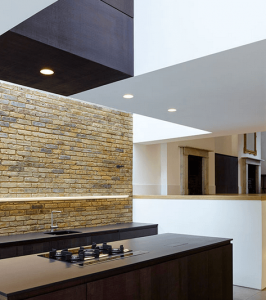People have been aware of the role ceilings can play in the aesthetics of rooms for a long time. That is why we see Artex and other patterns on so many older homes. You have the opportunity to create a ceiling in each room that can enhance its look and feel. We want to have a look at the six different types of ceiling materials you can use. Then, if you would like help with residential architecture in London, you can speak to us.
Plaster
 The most common option is plastering. It is one of the best choices if you consider the ratio of costs to benefits. What you get is a relatively low cost ceiling, whether you choose traditional plaster or gypsum. It can feature various decorative touches, and you also have the option to paint a colour of your choosing. At the same time, plaster has good acoustic and thermal performance.
The most common option is plastering. It is one of the best choices if you consider the ratio of costs to benefits. What you get is a relatively low cost ceiling, whether you choose traditional plaster or gypsum. It can feature various decorative touches, and you also have the option to paint a colour of your choosing. At the same time, plaster has good acoustic and thermal performance.
There are two drawbacks with plaster though. Firstly, it is not great in terms of water resistance. That means it can be a bad choice for rooms with high humidity, including bathrooms and kitchens. In addition, it can require maintenance to address cracking and discolouration.
PVC
A new option is to choose plastic panels. They are really good in terms of the aesthetics, offering a massive selection of styles and finishes. You can even choose panelling that imitates other materials, such as marble or wood. A lot of people like this option for ceilings because it is easy to clean and has great moisture resistance. That is perfect for bathrooms.
Again there are some drawbacks though. First, the PVC does not provide good acoustic or thermal insulation. That means rooms can be a little noisier and colder. Secondly, the panels have low fire resistance. As a result, they are not very good for any rooms with a fire risk.
Concrete
A lot of people are surprised by the fact you can use this material on the ceiling. However, thin sheets can be very good for residential architecture in London and many other buildings. The big selling point is the concrete offers good acoustic and thermal insulation. In addition, it can be impressively decorative. This is especially true if you choose a high polish or want an industrial look.
The main drawback here is the weight. Even thin concrete can be heavy, so the ceiling must be able to support the load. Plus, it can be quiet expensive.
Metal
We’ve all seen buildings with impressive cladding on the exterior. However, you can also use it to line ceilings. It is a versatile option thanks to the array of styles, finishes, colours, and textures. It can have really good resistance to humidity and can also prevent issues with bacteria and mould.
Again there are drawbacks though. For one thing, metal isn’t the best for thermal or acoustic insulation. More importantly, some metals are vulnerable to salt air and can suffer from corrosion.
Timber
A lot of people like using wood in residential architecture in London and other areas all around the world. Timbers are excellent in terms of aesthetics and insulation. In fact, wood can make rooms feel more comfortable and cosy.
There are two things to think about here though. First, it can be a costly option. Secondly, it can require a lot of maintenance, particularly because it can be vulnerable to moisture and pests.
Natural elements
There are several other natural materials you can use for ceilings. They can be a good alternative to timber in some cases, although they are most useful for exterior use. Popular options include bamboo and straw for the aesthetics.
The main disadvantage here is the materials may not be the most durable. As a result, they can require a lot of maintenance. Plus, there can be concerns about fire resistance.
Speak to us about residential architecture in London
Coffey Architects loves the fact we can use many different materials to give people their dream homes. You can be as creative as you want with your selection. You just need to think about the costs, maintenance, and performance, then choose whatever option works best for you in every room.
So, if you want to work with us to create stunning residential architecture in London, please get in touch. We’ll design the right property for you.
